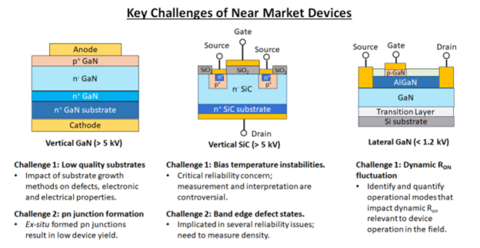Summary
The exponential growth in the power electronics market requires efficient devices based on wide bandgap (WBG) semiconductors. The yield of power devices is caused by both killer and non-killer defects. These defects hinder device functionality, reduce reliability, or lead to device failure, presenting a significant challenge in determining their impact.
This project will develop measurements that identify the cause of microscopic defects which can be adopted and implemented by device and materials simulation teams to formulate predictive models for performance and reliability.
Grand Challenge 4. Modeling and Simulating Semiconductor Materials, Designs, and Components
Description

Power electronics play a central role in all aspects of electrical energy storage, distribution, conversion, and consumption. Currently, power electronics heavily rely on Si-based insulated-gate bipolar transistors (IGBT), which have large footprints, are inefficient, and require extensive cooling. Power electronics based on wide bandgap semiconductors (WBG) have and will outperform Si devices at higher breakdown fields due to their intrinsic electronic properties.
Although some commercial WBG solutions exist, they are not widely utilized due to higher cost-to-performance ratio and perceived lower reliability. Most power reliability studies are based on research & development (R&D) grade devices and studies on commercial devices are far fewer. The processing technology, material, and structure of power devices play a central role on meeting specified device performance, and R&D devices are usually immature compared to commercial devices.
Understanding the role of killer defects to maximize device yield will have immediate economic impact.
This project’s synergistic approach to assessing the impact of non-killer defects on device performance will lead to reliable, better-performing power electronics components. Ultimately, the deployment of these more resilient devices will help improve the reliability and lifetimes of power electronic devices deployed in all aspects of the electrification revolution.

